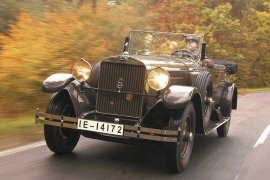
AUDI Typ R
Generations Timeline, Specs and Pictures

The first luxury car produced by Audi was the Typ R Imperator was the vehicle which drove the German brand to be bought by the largest motorcycle builder in the world, DKV.
Without having a tradition, or being known, as a luxury carmaker, Audi dared to introduce the eight-cylinder Typ R in its lineup in 1928. It was a very expensive vehicle, and it was a technological step back when compared with the previous Audi Typ M model. The high price-tag and the world economic crisis between 1928 and 1932 led to poor sales.
Like most of the vehicles from its time, the Typ R was available as a bare-chassis or as a complete vehicle from the factory. It was available as a coupe, a convertible, or as a Pullman limousine. All of them featured standard two spare wheels mounted either on the engine bay’s sides or behind the car. Its metallic-wire wheels featured a central locking bolt for an easy replacement in case of a flat tire.
Inside, for the four-door version, the Imperator offered a large interior thanks to its 3.6-meter (142 “5”) wheelbase. Its rear-hinged rear doors allowed an easier ingress and egress from the car. At the front, the carmaker installed the dials and gauges in the middle of the dash panel.
From the technical point of view, the Typ R slacked behind its predecessor, the Typ M. It featured a three-speed manual gearbox instead of four. Audi fitted the Imperator with mechanical brakes, while the model it replaced trusted on a hydraulic system.

Audi introduced the Type R in 1927 as a successor for the Type M, but with a lighter bodywork and better performances, but wasn’t that convincing on the market.
After leaving the Horch car manufacturer, which he established in 1904, August Horch started a new company, which he wasn’t allowed to name it after his name. He translated the German name into Latin, and the result was Audi, which is a verb for “to hear.” He aimed high and produced the Type M, which was too expensive for an unknown brand, and it wasn’t successful. In 1927 he came with another model, the Type R, which was shorter, lighter, and less expensive than its predecessor. Still, the luxurious limousine was too expensive for those times, and Audi sold just 145 cars.
The Type R Limousine was big and long even for those times. Due to its size and over-engineering solution, it was named Imperator (Emperor), and it was indeed a majestic car. Its short overhang and long engine compartment were followed by a closed cabin with three side windows and an abrupt end. The car’s side steps continued its front fenders. On each side of the engine compartment, Audi installed a spare wheel.
Inside, the Imperator offered a large interior for the four-door version thanks to its 3.6-meter (142 “5”) wheelbase. Its rear-hinged rear doors allowed an easier ingress and egress from the car. At the front, the carmaker installed the dials and gauges in the middle of the dash panel.
From the technical point of view, the Typ R slacked behind its predecessor, the Typ M. It featured a three-speed manual gearbox instead of four. Audi fitted the Imperator with mechanical brakes, while the model it replaced trusted on a hydraulic system, which was more effective but less reliable.























































